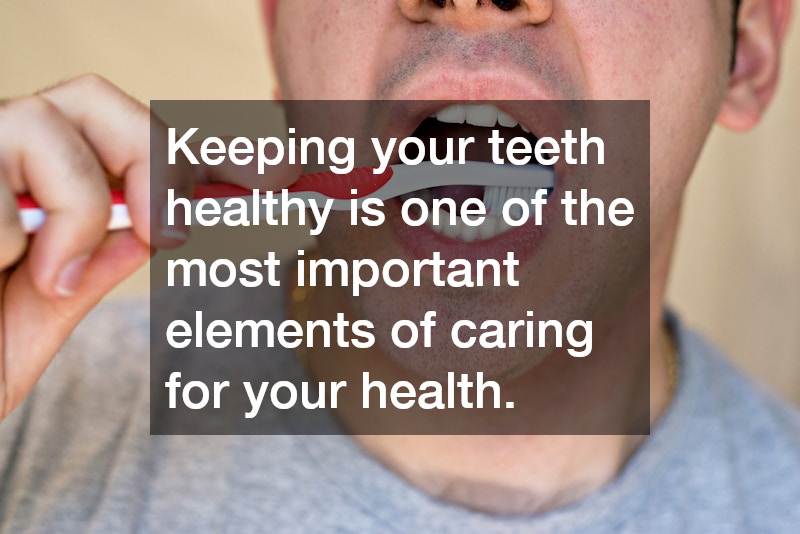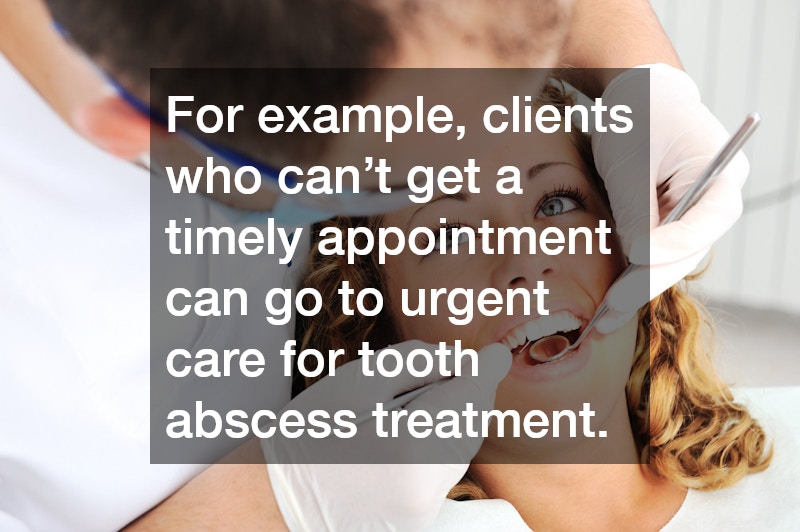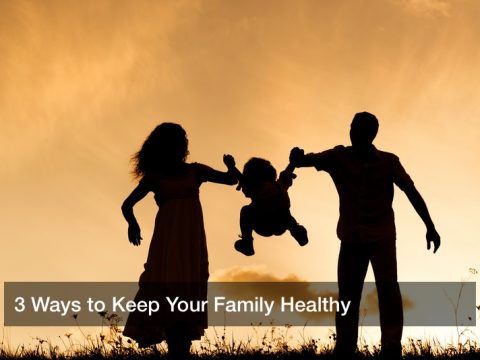Disclaimer: Healthy Lunches. This site provides food and drink content for informational purposes only.
Keeping your teeth healthy is one of the most important elements of caring for your health. If you’re a parent, your children’s dental health will be one of your important responsibilities. An annual visit to your dentist is a necessity, but when you have an emergency with your teeth, it may be time for you to visit a local emergency dental care facility.

Every night and day emergency dentist care is available only as a stopgap in the emergency room. According to the Cleveland Clinic, an emergency room can give you medication for pain relief and antibiotics (if appropriate), but you’ll still need to get to your dentist as soon as possible for dental treatment. In many communities, there are urgent care facilities available for emergency dental treatments.

For example, clients who can’t get a timely appointment can go to urgent care for tooth abscess treatment. If you have an abscess, you should gargle with salt water several times a day until you see a dental professional. According to the Cleveland Clinic, although you can go to urgent care for tooth infection treatment (like an abscess), you should let your regular dentist know about your urgent care visit.
In a large and ever-changing world, one of the most important things humans need is connection. The most immediate connection we have to another human being is through our families. A healthy family unit can provide the support we need for each other to continue facing the challenges life throws at us. From preschool-age children to aging parents, everyone deserves attention and proper care. No one should be forgotten.
As we continue into the new year, there are several things that should be remembered to keep your family strong both physically and mentally. Start with a simple home health care routine such as packing a healthy lunch. Then develop an exercise routine. Make sure you have a proper health center available if one of you gets injured and then take measures to make sure your home is up to date on all of its features so that the building structure is sound and safe to live in.
Home Health Care
Home health care includes both diet and exercise. There must be a balance between the two to keep your kids healthy and active. Aging parents need close attention so they can maintain their health as they creep into their older years. Start with something as simple as creating a healthy lunch. A healthy lunch will have nutrient-rich foods that reduce the chance of debilitating diseases anywhere from 80 to 90 percent.
Start with meal prepping. It is estimated that 20% of all meals in America are eaten in a car. Meal prepping is a way to monitor and control your diet when your schedule gets busy. You set aside a specific time to prepare meals in their entirety so you can grab and go something healthy when you barely have time to eat. Portion sizes are regulated so you don’t accidentally overeat. This helps reduce munchies and useless snacking that won’t give you the energy you need to keep going throughout the day. It also saves money that adds up quickly with the continuous purchasing of fast food meals.
For example, if you want to prep a healthy lunch:
- Large batches: Cook in large batches to save time and energy. Grains and pasta are a great choice to dump in a large pot and let boil for a while.
- Storage: Make sure you have containers for whatever you are cooking. If your healthy lunch is pasta with vegetables on the side, maybe have separate containers or storage containers that have different sections. Sections help visualize portion sizes better.
- Future Storage: The nice thing about cooking in large batches is that you will likely have more food than you need for the week. If you will not eat the food within five days, it should be frozen for another time. This is a bonus because the excess of food means you may not have to cook as much the following week, and if needed, a frozen ready-to-go healthy lunch can become a healthy dinner in a pinch if needed!
In addition to the healthy lunch planning, also start planning an exercise routine for your family. Be each others life coaches! The food will give you the energy to develop a fitter body. A few tips below can help you fit some exercise into your day.
- Plan Ahead: Just as you did for a healthy lunch, look several days in advance. Maybe while you’re cooking pasta, grab your calendar and start planning what days you will have the most time to exercise. On the days with more time, take the kids to the park. You can run while they play on the playground. On shorter days, fit in smaller workouts throughout the day. Break it up so it doesn’t feel overwhelming.
- Gather Friends: If you need to catch up with friends, invite them along. Exercising with a friend makes it more fun for everyone and it is also someone to keep you and your family accountable. It gives a feel of, “we’re all in this together!” You might even create friendly rivalry to encourage the kids to be more active.
- Track Activity: Track what you do. Write it down. Run with an app. Use a pedometer. In addition to having a friend, tracking activity will also hold you accountable and let you know how well you are doing at keeping exercise in the routine.
Emergency Care
Home health care is the first step to keeping kids and aging parents at their best. A healthy lunch can go a long way, but sometimes the body still succumbs to infections, kids get rambunctious and break bones, and aging parents need access to good health care. Make sure there is a 24 hour emergency care center close by. You never know when you or a family member might need emergency care or medical attention.
Signs of a good emergency care center include the following:
- History: Depending on what signs your preschool kids or aging parents present, one of the first things the receptionist or doctors should ask about is history. This should be an individual history of the person being seen, a recount of what lead up to the need to visit and also a family history. They should also ask about allergies or reactions to specific medications or if they are taking certain medications.
- Evaluation: A complete examination should assess pain. If it’s pain, some things the doctor might ask are where it hurts, how it feels, the intensity of the pain, and if it’s radiating elsewhere. They may test the area or poke and prod at it to see what kind of reactions are experienced. Since the point is to diagnose, it may be hard to determine how thorough the doctor is, but you should feel the doctor has taken the time needed to appropriately assess the situation. If you feel at all rushed or if the doctor is not giving you or your loved one the proper attention, it may be time to find a new emergency care center.
- Discharge Instructions: The visit is important to figure out the problem, but the discharge papers are equally important. These are the instructions for the aftercare, what the person can and cannot do along with instructions for medications. If it is a bone repair injury, the doctor should provide a timeline of suggestions that may include making sure the cast doesn’t get wet, that no physical activity is done or that no strain is placed on the area. The discharge papers should have everything you need to know for the time following the visit and contact information if you have any further questions.
- Open Regularly: Ideally, you want a 24 hour emergency care center so you know you and your family are covered. If this is not the case, make sure there is at least a hospital nearby. If you do have a 24 hour emergency care center, another thing to watch for is how busy they are. Regular business is a sign that they are respectable, but if they are too busy, you don’t want to be stuck waiting longer than you need to for medical attention. Take time to scope out the area and just like your healthy lunch and exercise planning, devise a system beforehand so you know what your plan is before an emergency arises.
Quality Home Space
Now that you’ve got family, a diet plan with a solid healthy lunch, an exercise routine that plans days in advance, and the nearest locations identified for emergency centers, you need to take a look at your own living space. Make sure you live in a place that feels comfortable and safe for the entire family. This includes the neighborhood as well as keeping up with the general maintenance of the house. Chances are you are going to be inside a majority of the time so it needs to be a clean and functional environment.
First and foremost, you need to make sure you have a roof over your head. Literally. This is one of the most important parts of a house. While a good roofing job can last several years, you’ll want to regularly check it for damage. This could be from strong weather, branches, or even an excessively wet year.
From the outside, watch for shingles that are curled, cracked, or missing entirely. This exposes the underside of the roof. Look for shingles that might be dark or wet and look for pieces of them in the gutters or in the yard. Depending on the type of roofing material, the shingles can gradually disintegrate over time. Other things to keep an eye out for include sagging in the roof, pooling water, general wear and tear, and any warps or blistering of the material.
From the inside, look for leaks, stains on the ceiling or walls, and the presence of outside light peaking through cracks. If any of these things show up, get them fixed immediately as little problems can quickly turn into larger problems. Even if it seems minor, it may be underlying a major structural component of the roof that could put your family at dangerous risk.
If you live in a tropical climate, close to the ocean, in addition to a well-roofed home, you’re going to want to consider hurricane proof windows. Hurricane proof windows are made with impact-resistant glass. They are strong and enforced with either a layer of polyvinyl butral or ethylene-vinyl acetate. These windows work like car windshields. They crack and spider out into the glass rather than shattering into pieces.
The installation of these windows is just as important as what they are made out of. Frames that are commonly used consist of aluminum, steel, vinyl, or wood. Aluminum and steel are the most expensive, but also the most efficient. Vinyl is hard to recycle later in life and wood requires regular maintenance. After windows are installed, just like with the roof, keep up on making sure there are no issues. Windows are important to let light in the house, but also moderating the air temperature and air quality of the home. If it feels cold all the time, you can see light coming through the seals, or things are growing on the window panes, it may be time to have someone come take a look. It also compromises the structural integrity overall and you certainly don’t want things growing on them if you have children around. They don’t need to be breathing in mold.
Lastly, consider switching your home to more efficient and clean energy. Clean energy uses innovative ways to power homes. Some examples are turbines or solar power. Clean energy is the energy that is considered renewable and green. It reduces the use of fossil fuels and thus improves air quality. The use of clean energy locally also diversifies where energy is pulled from, further reducing the need for fossil fuels. Globally, clean energy creates more jobs as more research is being done and the installation requires more hands on deck to make it happen. So not only are you helping out your own family by committing to a cleaner environment, you are helping out families of others by creating more job opportunities.
The Final Measures
Taking care of you and your family should be a priority in life. It doesn’t have to be hard. Most of it is thinking ahead and making a plan. Start with at-home health care. Remember that healthy lunch? Make sure you are meal prepping so you are able to provide a healthy lunch each and every day to your children and your own parents. Turn sitting time into exercise. Break up the routine or invite friends over to keep you and your family on track. Even if diet and exercise are going as planned, you never know when someone might get sick or injured. Make sure you have access to a 24 hour emergency care center. Make sure they are reputable. Lastly, home is where the heart is so making sure you live in one that is structurally stable. Stay on top of the roof maintenance, check windows regularly, and try switching to clean energy that will benefit your families and others for the long term.




